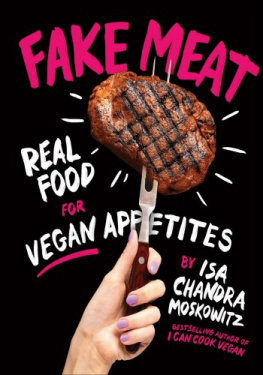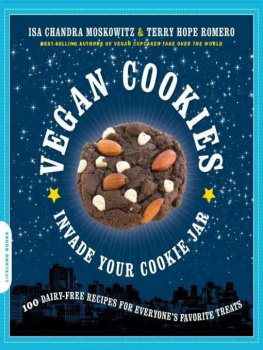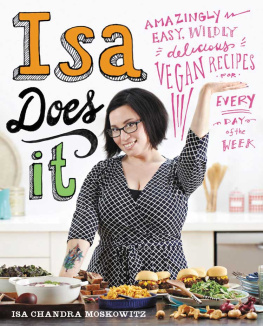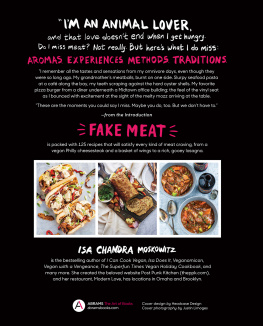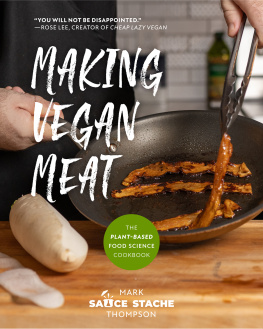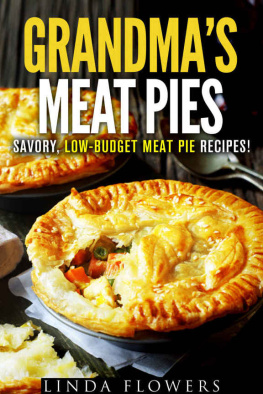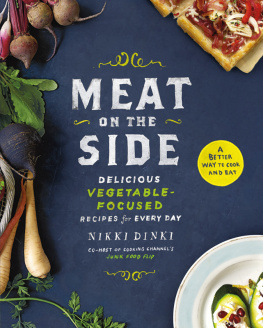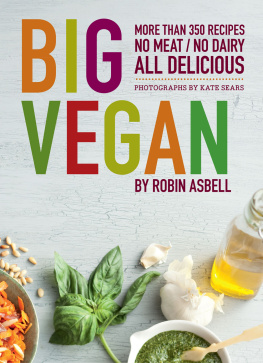Editor: Holly Dolce
Designer: Headcase Design, www.headcasedesign.com
Design Manager: Heesang Lee
Managing Editor: Lisa Silverman
Production Manager: Sarah Masterson Hally
Library of Congress Control Number: 2022933607
ISBN: 978-1-4197-4745-8
eISBN: 978-1-64700-861-1
Text copyright 2022 Isa Chandra Moskowitz
Photographs on copyright Justin Limoges
Photographs on copyright Kate Lewis
Photographs on copyright James Walmsley
Cover photograph copyright Justin Limoges (In case you are wondering what the cover meat is, its the burger, marinated in beet powder and grilled. Hand model: Dawn Sailors)
Cover 2022 Abrams
Published in 2022 by Abrams, an imprint of ABRAMS. All rights reserved. No portion of this book may be reproduced, stored in a retrieval system, or transmitted in any form or by any means, mechanical, electronic, photocopying, recording, or otherwise, without written permission from the publisher.
Abrams books are available at special discounts when purchased in quantity for premiums and promotions as well as fundraising or educational use. Special editions can also be created to specification. For details, contact specialsales@abramsbooks.com or the address below.
Abrams is a registered trademark of Harry N. Abrams, Inc.

ABRAMS The Art of Books
195 Broadway, New York, NY 10007
abramsbooks.com


CONTENTS

INTRODUCTION
WHY FAKE MEAT?
How boring would life be if we didnt try new things? I am speaking about we as a civilization, and we as individuals who make breakfast.
Thousands of years ago, in the volcanic ash of the Andes, someone found a knobby clump and figured out a way to eat it.
What could this be?
She turned the clump over in her hands. It sprouted vines and small flowers and those vines led to more vines which led to more clumps. She smashed one with a rock. It split. She bit into it. She probably died.
But the community kept the seeds from the ones that didnt kill anyone. Again and again, year after year, seed after seed. That clump became a potato, or at least potato-ish. They kept at it. Cross-pollinating it in different soils, on reverse sides of the mountain, identifying the insects that did damage, and the ones that helped. The potatoes that survived, they thought, lets keep those.
Years passed. Thousands of years passed.
Today, we have french fries. We dont even think about how lucky we are, or how close we came to never having them. Both the fries, and us, may never have existed, had no one moved some poisonous vines just a few feet higher.
What could this be?
Food evolves.
Take meat. It wasnt until the Middle Agesa time period when Europeans talked real weirdthat meat even meant capital M MEAT. Mete simply meant food. So, when one serf asked another if he wanted some mete, no one started tweeting furiously that mete wasnt really mete. The mete industry didnt sue anyone. We simply ate it without question, probably without really caring what the word meant.
Because words evolve.
Both of these things, language and dinner, have held hands down a grassy path since the dawn of civilization.
I use the term fake meat in part because as a child I went to Jewish sleepaway camp in the Catskills, making me a natural comedian. This description is tongue in cheek, yes, but its also true. Although it may not be true forever.
OK, thanks for the history lesson, now how do I make vegan chicken nuggets? I hear you, we are getting there.
Before that, a little story.
The first time I tried mock meat, as we called it back then, I was on a bus in Brooklyn, straphanging with a friend after watching Indiana Jones and the Last Crusade . He was pissed because I talked through the whole movie, a trait that I find charming but everyone else finds annoying.
I had recently joined a Buddhist temple. The congregation was kind, and it necessitated that I build a shrine in my bedroom filled with kumquats, cool art, and scarves that smelled like an incense shop.
He was making fun of me about that, and I was making fun of him because thats what teenagers do on public buses.
I wasnt vegetarian yet, but I had thought about it. To be honest, I wasnt sure the meat I was eating even contained that much meat (remember Steak-umms?) Still, I was dissing him for being vegetarian. And he said I should be, too, if I was going to be Buddhist.
And this is where the story gets weird. He pulled a little zip-top bag out of his ripped jeans pocket.
Inside were saucy, mahogany bits of food, which I learned to be wheat gluten. I refer to it, still to this day, as the pocket seitan. He asked me to just try it, and I never turn down a dare.
Days later he took me to the origin of the pocket seitan: a restaurant in Chinatown called House of Vegetarian. On the menu, Hot Steak Kew. Much better warm on a plate. Chewy morsels covered in savory gravy that I still cant crack the code on.
It was there, dipping my dumplings into the leftover sauce, that I decided to give up meat.
Do I miss it? I dont, which is ironic, maybe, since I am hell-bent on re-creating it. But I didnt give up meat because I didnt like it. I just realized that I could never look a cow in the eye, her big, beautiful eye, with the gorgeous eyelashes, and cause harm to her. And why cant my eyelashes look like that?
As a child, I cried at Bambi . I tried to save every dog I found. I talked to my cat like he was my personal therapist.
Im an animal lover and that love doesnt end when I get hungry.
But heres what I do miss: Aromas. Experiences. Methods. Traditions. And as for that last one, traditions, Ive been creating new ones for over thirty years.
My brain must be a gravy boat because I remember all the tastes and sensations from my meat-eating days, even though they were so long ago. My grandmothers meatballs, burnt on one side. Stuffed clams at a caf along the bay, crusty on top, my teeth scraping against the hard shell. My favorite pizza burger from a diner underneath a midtown office building, the feel of the vinyl seat as I bounced with excitement at the sight of the melty mozz arriving at the table. Reaching for spareribs from the Chinese restaurant, in a white foil bag, each one smothered in caramelized sauce that you sucked off your fingers.
These are the moments I guess you could say I miss. But I dont have to.
The point isnt always to completely re-create the inspiration. Often, its an invocation, a rough translation. Some are more realistic than others. Could a vegan Philly Cheesesteak trick anyone? Most likely. But will someone mistake a cauliflower wing for a piece of chicken? Probably not. Instead it suggests, hey, a cauliflower wing is its own delicious thing. And Im going to call it a wing because it invokes a wing. And you cant stop me.
What could this be?
In a hundred years will a new generation be discussing how a wing once came from an actual animal? No one would ever possibly believe it.
Needless to say, fake meat has been around a lot longer than me. By the time I put my chopsticks down and savored the very last of my very first fake meat experience, it had already existed for hundreds, maybe thousands, of years. Recipes for fake lamb appear in a Chinese cookbook from 900 CE. Mostly it was tofu.
Next page
